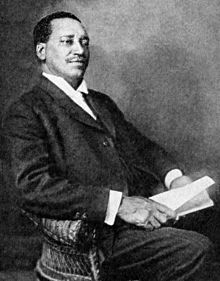William Henry Sheppard
| William Henry Sheppard | |
|---|---|
 |
|
| Born | March 8, 1865 Waynesboro, Virginia |
| Died | Nov. 25, 1927 (aged 62) Louisville, Kentucky |
| Occupation | Presbyterian missionary |
| Known for | Missionary work in the Congo and reporting the exploitation of the Congolese by Leopold II of Belgium |
William Henry Sheppard (1865–1927) was one of the earliest African Americans to become a missionary for the Presbyterian Church. He spent 20 years in Africa, primarily in and around the Congo Free State, and is best known for his efforts to publicize the atrocities committed against the Kuba and other Congolese peoples by King Leopold II's Force Publique.
Sheppard's efforts contributed to the contemporary debate on European colonialism and imperialism in the region, particularly amongst those of the African American community. However, it has been noted that he traditionally received little attention in literature on the subject.
Sheppard was born in Waynesboro, Virginia on March 8, 1865, to William Henry Sheppard, Sr. and Fannie Frances Sheppard (née Martin), a free "dark mulatto", a month before the end of the American Civil War. No records exist to confirm William Sr.'s status as a slave or freedman, but it has been speculated that he may have been among the slaves forced to serve the Confederacy as Union troops marched upon the South. William Sr. was a barber, and the family has been described as the closest to middle class that blacks could have achieved given the time and place. At age twelve, William Jr. became a stable boy for a white family several miles away while continuing to attend school; he remembered his two-year stay fondly and maintained written correspondence with the family for many years. Sheppard next worked as a waiter to put himself through the newly created Hampton Institute, where Booker T. Washington was among his instructors in a program that allowed students to work during the day and attend classes at night. A significant influence on his appreciation for native cultures was the "Curiosity Room", in which the school's founder maintained a collection of Native Hawaiian and Native American works of art. Later in life he would collect artifacts from the Congo, specifically those of the Kuba, and bring them back for this room, as evidenced by his letters home, such as "[i]t was on the first of September, 1890 that William H. Sheppard addressed a letter to General Samuel Armstrong, Hampton, From Stanley Pool, Africa, that he had many artifacts, spears, idols, etc., and he was '...saving them for the Curiosity Room at Hampton'".
...
Wikipedia
